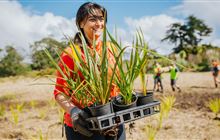Volunteers help protect petrels from predators
Introduction
A camera set up by conservation volunteers to monitor a grey-faced petrel/oi burrow near Oakura is showing just how vulnerable the sea birds are, with a plethora of predators visiting the site.Date: 20 June 2024
Restore Oakura comprises a group of local volunteers set up to trap predators in their back yards and around the coastal community. The volunteers’ collective effort can be traced back to 2019, when Toby Shanley from Restore Oakura heard the distinctive call of the grey-faced petrel and did some investigation, subsequently finding several of the sea birds and a burrow.
This week is Te Wiki Tūo ā-Motu, National Volunteer Week where those who give their time to the community and environment are recognised – like the Restore Oakura volunteers. Toby, along with other volunteers from Restore Oakura, set about protecting the birds by installing traps around the area.
Proof of the birds’ vulnerability came when the group installed a trail camera to monitor the burrow. What they saw came as a shock: a ferret, stoats, a dog and, most recently cats, visited the borrow with the nesting adults inside.
In 2022 a ferret killed a chick in the nest before it could fledge.
“All these different visitors to the same burrow show just how in danger these birds are,” says Toby.
A donation from Oakura local Norton Moller allowed the installation of further traps to protect the burrow and a section of the coastal walkway from Ahu Ahu Road to the Oakura campground where the seabirds were seen.
Grey-faced petrel colonies are dispersed across coastal North Island, but Taranaki’s only other confirmed mainland colony was at Rapanui, a predator fenced area near rural Tongapōrutu.
Grey-faced petrels spend most of their time at sea where they are fast and graceful, soaring on the sea breeze he explains.
“Returning to land they are clumsy and slow and nest in burrows so they are really vulnerable to predators.”
Every two weeks a volunteer checks the approximately 2km trap line. The hard work paid off when a chick successfully fledged in 2023.
The increase in trapping through the local Oakura and region-wide Predator Free Taranaki. programmes meant mustelid numbers are being knocked back which could be seeing an increase in coastal birds coming back to the region says Toby.
“We are doing further monitoring around the coast to see if birds are coming in at night and it’s looking promising.”
But the protection needs to continue and grow: “They need ongoing protection in order to help them survive and thrive.”
He’s asking people to help by keeping their dogs in sight and under control when walking them along the Taranaki coast.
Cat owners can have their pets spayed and keep them indoors at night.
People can get involved by setting traps in their back yards or volunteering for a local trapline.
Contact
For media enquiries contact:
Email: media@doc.govt.nz

